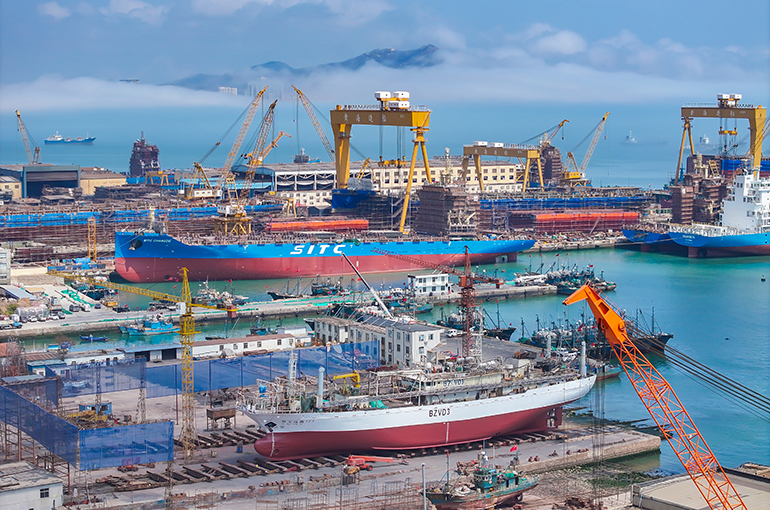 Realities of China, US Shipbuilding Industries Show Absurdity of Section 301 Investigation
Realities of China, US Shipbuilding Industries Show Absurdity of Section 301 Investigation(Yicai) April 15 -- The United States has launched a Section 301 investigation into China’s shipbuilding industry, and the President Donald Trump signed an executive order known as Restoring America’S Maritime Dominance on April 9, accusing China of gaining competitive advantages through so-called “unfair practices.” This not only ignores the fundamental dynamics of global shipbuilding but also reveals a serious misjudgment of how modern industrial systems operate.
This article compares the shipbuilding industries of China and the US in five key areas -- construction costs, production efficiency, technological innovation, supply chain systems, and economies of scale -- to demonstrate that the root causes of America’s declining competitiveness are its hollowed-out industrial chain, shortage of skilled workers, and dysfunctional support systems. The only way the US can address its shipbuilding challenges is to deal with these structural flaws in its own economy. As the saying goes, giving medicine to others will not cure your own illness.
1. Vessel Costs
Data from shipping and trade analysts Clarksons Research shows that newbuild prices at US shipyards can be up to six times higher than those at Chinese yards for certain vessel types. For example, when a 2,200-ton wind turbine installation vessel was ordered in 2020, a US shipyard gave a quote of USD625 million, while Chinese shipyards offered quotes of around USD330 million. In 2022, Matson Navigation commissioned three 3,600 twenty-foot equivalent unit dual-fuel container ships from Philadelphia Shipyard, with each vessel costing about USD333 million. Comparable ships built in China cost just USD55 million.
China’s shipbuilding supply chain has achieved significant progress in recent years, reducing reliance on foreign suppliers and lowering costs. The Yangtze River Delta now hosts the world’s largest shipbuilding industrial cluster, where the synergistic effect generated by geographical clustering not only slashes logistics costs but also promotes communication and cooperation between upstream and downstream parts of the industry chain.
By contrast, the localization rate of US shipbuilding components stands at just 41 percent, with critical equipment fully dependent on imports. This is a consequence of industrial hollowing-out and high domestic production costs.
2. Production Efficiency
Through optimized workflows and advanced technologies like automation and digitalization, China’s shipbuilding industry has dramatically shortened construction cycles. Jiangnan Shipyard near Shanghai, for instance, reduced the build time for large container ships from 28 months to 13 months using “digital shipbuilding” technologies.
A Cato Institute report found that US shipyards require 40 percent to 60 percent more labor hours to build a vessel compared with foreign counterparts. The inefficiency and long construction cycles stem directly from the protectionist Jones Act, which rather than revitalizing US shipbuilding has stifled the nation’s global competitiveness.
China has made strides in smart manufacturing, with 3D model sharing rates exceeding 80 percent and improved design efficiency, but the US lags behind in civilian shipbuilding automation, despite leading the world in military vessel technology.
3. Technological Innovation
China is the only nation capable of simultaneously constructing aircraft carriers, large liquefied natural gas carriers, and cruise ships. By the end of 2024, China accounted for 77.4 percent of global very large crude carrier orders, 91.6 percent of orders for container ships above 17,000 TEU, and 30 percent of LNG carrier orders, up from 6.8 percent in 2020, according to Clarksons.
In the high-tech vessel sector, the US mainly focuses on military and specialty vessels, and it has made some research and development advances in green and smart shipping technologies. However, to transform these technologies into actual productivity and achieve industrial application, the US still needs to overcome a series of bottlenecks.
4. Supply Chain
China’s cost advantages derive from robust local supply networks and industrial cluster synergies that minimize logistics expenses and promote exchanges and collaboration between upstream and downstream parts of the industry chain.
Conversely, industrial hollowing-out in the US has speeded up the relocation of manufacturing overseas, leading to gaps in the industrial chain. Coupled with high production costs, this has crippled the supporting system for the US shipbuilding industry. In the division of global industrial chains, the US solely focuses on domestic production, failing to integrate into the efficient shipbuilding supply chain network dominated by Asian countries, China, Japan and South Korea in particular.
5. Economies of Scale
China’s annual shipbuilding capacity has reached 23.25 million tons, which is 232 times that of the US. China operates over 75 large shipyards, while US yards focus predominantly on military vessels, per data from the US Office of Naval Intelligence.
In 2024, Chinese shipyards delivered 1,286 new vessels with a total tonnage of 39.12 million, representing 54.6 percent of global output, according to Clarksons. Meanwhile, US yards delivered just 28 ships with a total tonnage of 300,000, accounting for 0.04 percent of the global share. The 28 ships included six passenger vessels along with workboats and tugs, but zero oceangoing cargo ships.
China’s scale-driven marginal cost reductions offer a significant advantage for its shipbuilding industry. As production capacity increases and technology advances, the unit cost gradually decreases. This enables Chinese shipyards to offer more competitive prices and services, thereby continuously enhancing their leading position in the global market.
(The author is former chief engineer of Cosco Shipyard Group.)
Editor: Tom Litting